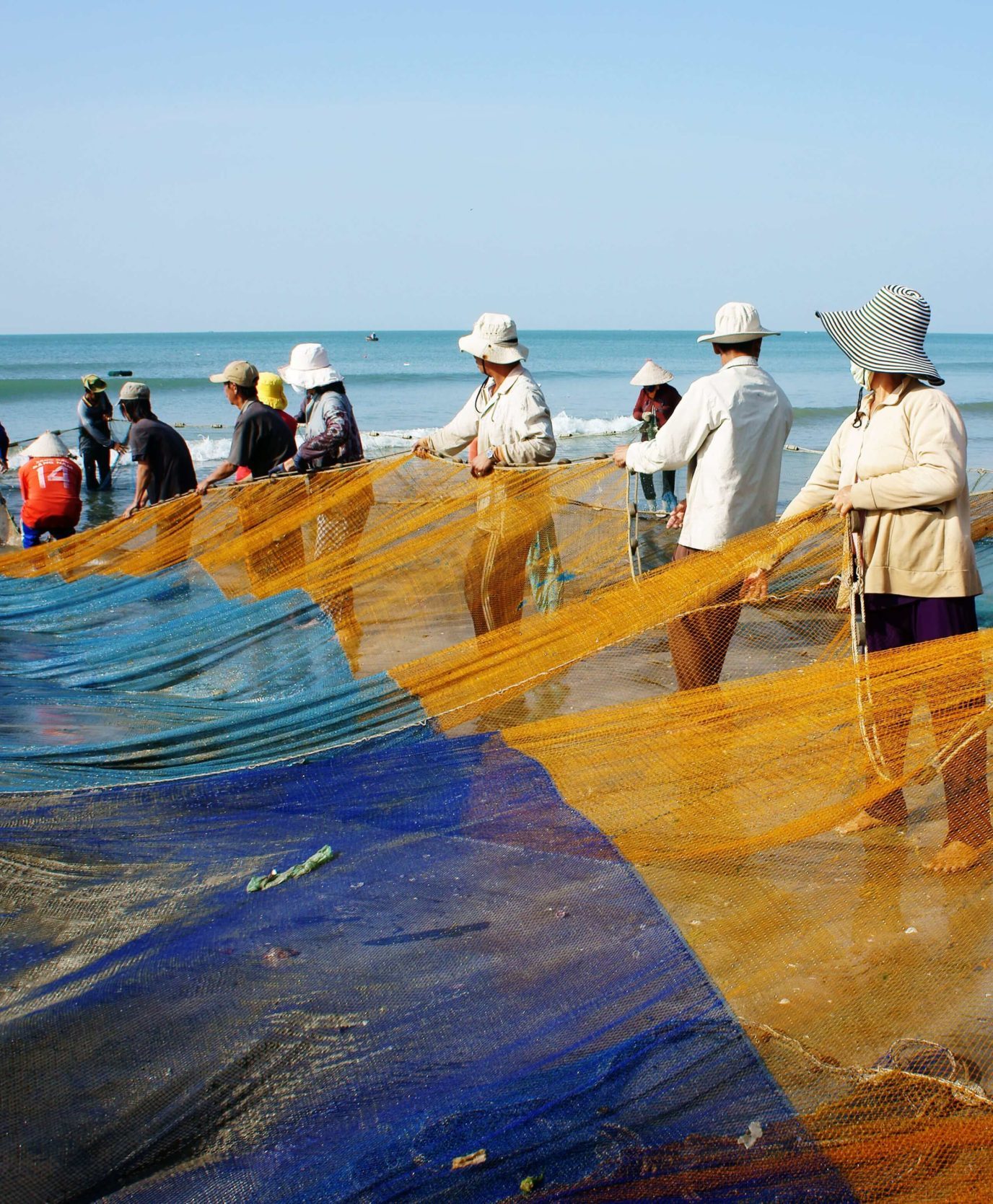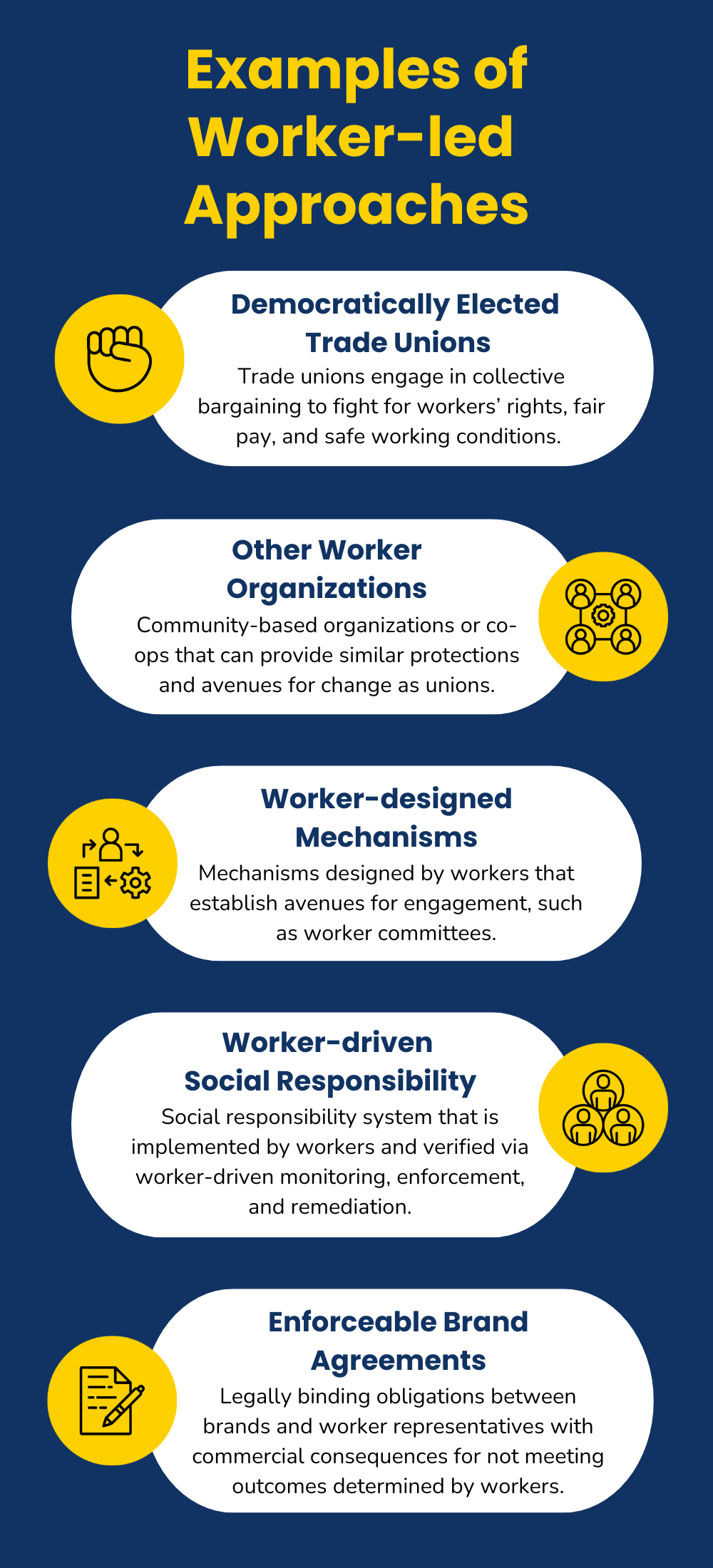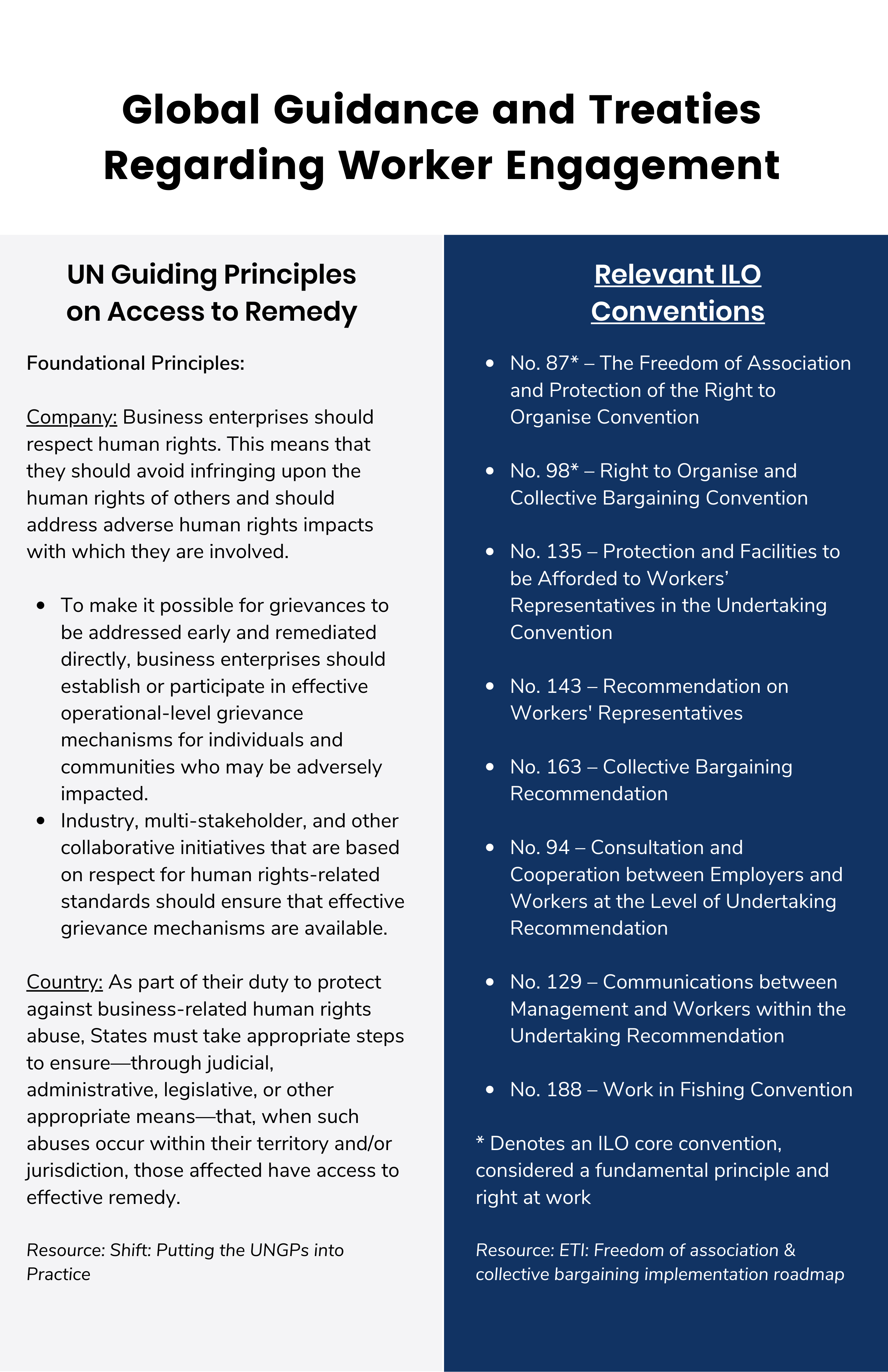Worker Engagement
When workers participate and engage, business operations improve.

Engaging with workers in your direct operations and in suppliers’ operations, including in processing facilities and on board vessels, is the most effective way to prevent and address human rights issues in seafood supply chains. Because seafood workers are involved with every aspect of production and processing, they know what needs to change in their workplace.
The most vulnerable workers in seafood are typically those closest to the product source. Fishing, especially in international waters, is in need of effective worker engagement mechanisms. Workers on commercial fishing vessels, especially migrant workers, are vulnerable to exploitation and abuse due to the combination of limited oversight, discriminatory laws, and lax enforcement.
Workers on vessels are hampered by their isolation, which limits their ability to communicate with personal networks or advocacy organizations. Also, unionization rates for at-sea workers are relatively low. Sectors like fisheries—in which the work occurs in remote locations with sporadic or infrequent access to communications—are difficult to organize.
How to Implement Worker Engagement?
At minimum, companies must implement effective grievance mechanisms. These mechanisms should incorporate training on how to use the reporting tool, transparency about next steps, and a case management system with support for workers who report grievances to protect them from threats or retribution. However, grievance mechanisms are only one part of a worker engagement strategy, because they identify issues after they have occurred.
There are several better ways to incorporate worker voices in the HRDD process:
- Engage with a union or other worker-led association, if one is in place, to hear what is important to the workers within a particular supply chain or region.
- Seek out a worker-trusted local service organization or gathering place, if workers are not organized.
- Solicit worker opinion through surveys and interviews, using tools like the Social Responsibility Assessment (SRA) and in-depth Human Rights Impact Assessments (HRIA).
- Develop an action plan in consultation with workers who will be impacted by it. If workers indicate that something needs to change, work hard to change it, and return to share the results, even if unsuccessful.
- Validate any change in work conditions through direct engagement or measures like grievance mechanisms or surveys.
Freedom of association and collective bargaining are fundamental worker rights that create the conditions for the protection of other core labor rights. Where there are unions, they are the best avenue to engage with workers. Unions are led by workers and represent them as they collectively fight for their rights, fair pay, and improved working conditions. Companies and unions have goals in common: to eliminate human rights abuses and labor exploitation and to encourage industry stability. Foster good relationships built on transparency, effective communication, and commitment to protecting worker rights.
The right to freedom of association and collective bargaining is legally limited or underused in some regions and sectors, such as in high seas fishing. In these cases, companies can partner with international organizations, local community organizers, and trusted local organizations to reach workers.
Worker-Led Initiatives
Regardless of the type(s) of worker engagement used, success depends on worker uptake. When workers are enabled and empowered, particularly when they can organize and enact collective bargaining, their rights are better protected, and conditions are much improved. When workers can develop, implement, and monitor conditions for themselves, the risk of human rights abuses and labor exploitation is reduced.

You can support seafood workers in eight ways:
- Align supply chain policies, practices, and commitments to uphold workers’ right to freedom of association and collective bargaining.
- Require workers to be educated and trained on their rights; contribute resources to make it happen.
- Require employers to collaborate with workers on a code of conduct, which includes support for workers’ ability to organize.
- Prioritize purchasing from suppliers and countries that protect workers’ right to organize.
- Consider adding incentives for suppliers showing stronger commitments to worker organization.
- Require and support the implementation of a trusted grievance mechanism, remediation processes, and associated user training as part of job training.
- Require employers to adopt anti-retaliation policies with associated training for supervisors.
- Require Wi-Fi access for workers on board vessels, with an access agreement that includes terms, hours of use, and privacy stipulations; this will help ensure their freedom of communication and ability to access grievance mechanisms.
-
Successful worker engagement lets workers and management improve working conditions and identify other issues. It may even lead your company to adapt its governance approach to increase worker participation.
Why Worker Engagement Matters
The United Nations Guiding Principles on Business and Human Rights report reminds companies to enable, establish, and uphold core labor standards, independent of whether a country’s laws fulfill its human rights obligations. Worker engagement is especially important in supply chains where workers have little or no access to formal protections or judicial remedies. When workers are enabled and empowered, particularly when they can organize and enact collective bargaining, their rights are better protected, and conditions improve.
When the risk of human rights abuses and labor exploitation is reduced, the risks and related burden to end buyers, brands, and suppliers are also reduced. When standards and rights are upheld, you benefit from strengthened operations, enhanced knowledge about supply chain issues, data to verify working conditions, and increased confidence.

- Freedom of Association in Practice: Lessons Learned report from ILO
- International Union of Food (IUF) and IndustriALL and other union groups like them
- Worker Voice Continuum from RISE
- Worker Voice on Fishing Vessels from Global Seafood Alliance
- Human Rights Due Diligence: Fundamentals for Impactful Implementation in Seafood from RISE
- Engagement in the Workplace: Information for Managers from FishWise
Guidance on setting up a protocol for relations between management and workers from ILO
RISE E-Learning
Check out the RISE e-learning module “Worker Engagement” to learn more.
